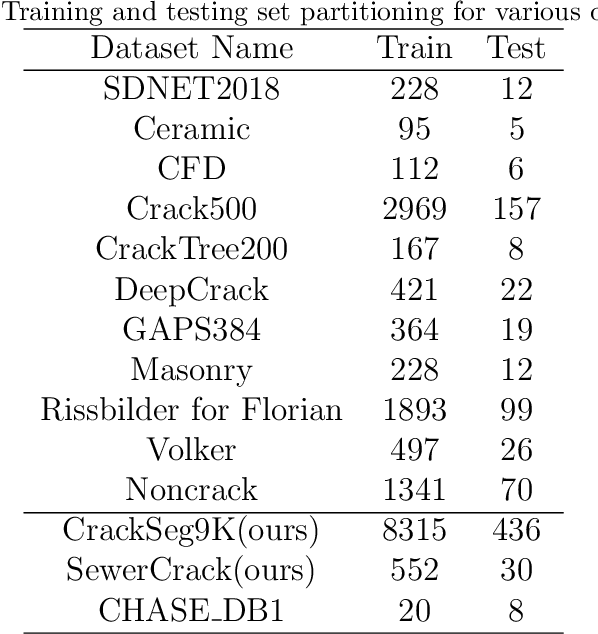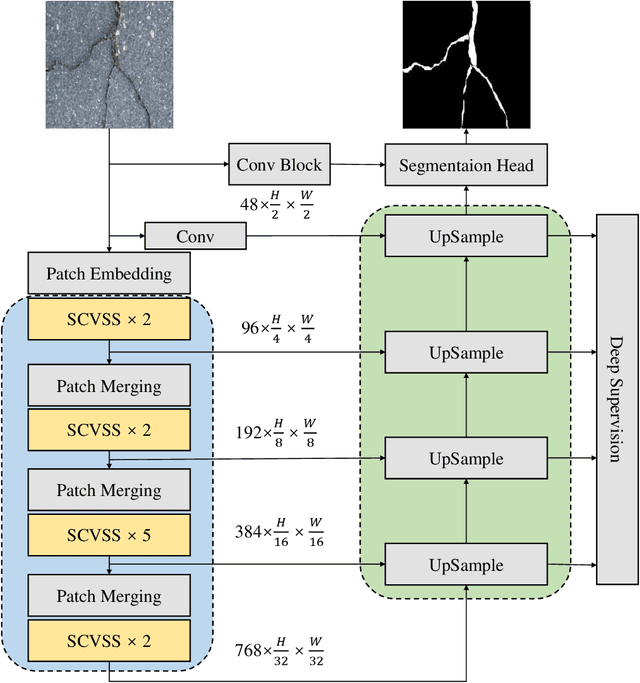Jifeng Shen
Improving underwater semantic segmentation with underwater image quality attention and muti-scale aggregation attention
Mar 30, 2025Abstract:Underwater image understanding is crucial for both submarine navigation and seabed exploration. However, the low illumination in underwater environments degrades the imaging quality, which in turn seriously deteriorates the performance of underwater semantic segmentation, particularly for outlining the object region boundaries. To tackle this issue, we present UnderWater SegFormer (UWSegFormer), a transformer-based framework for semantic segmentation of low-quality underwater images. Firstly, we propose the Underwater Image Quality Attention (UIQA) module. This module enhances the representation of highquality semantic information in underwater image feature channels through a channel self-attention mechanism. In order to address the issue of loss of imaging details due to the underwater environment, the Multi-scale Aggregation Attention(MAA) module is proposed. This module aggregates sets of semantic features at different scales by extracting discriminative information from high-level features,thus compensating for the semantic loss of detail in underwater objects. Finally, during training, we introduce Edge Learning Loss (ELL) in order to enhance the model's learning of underwater object edges and improve the model's prediction accuracy. Experiments conducted on the SUIM and DUT-USEG (DUT) datasets have demonstrated that the proposed method has advantages in terms of segmentation completeness, boundary clarity, and subjective perceptual details when compared to SOTA methods. In addition, the proposed method achieves the highest mIoU of 82.12 and 71.41 on the SUIM and DUT datasets, respectively. Code will be available at https://github.com/SAWRJJ/UWSegFormer.
Topology-aware Mamba for Crack Segmentation in Structures
Oct 25, 2024



Abstract:CrackMamba, a Mamba-based model, is designed for efficient and accurate crack segmentation for monitoring the structural health of infrastructure. Traditional Convolutional Neural Network (CNN) models struggle with limited receptive fields, and while Vision Transformers (ViT) improve segmentation accuracy, they are computationally intensive. CrackMamba addresses these challenges by utilizing the VMambaV2 with pre-trained ImageNet-1k weights as the encoder and a newly designed decoder for better performance. To handle the random and complex nature of crack development, a Snake Scan module is proposed to reshape crack feature sequences, enhancing feature extraction. Additionally, the three-branch Snake Conv VSS (SCVSS) block is proposed to target cracks more effectively. Experiments show that CrackMamba achieves state-of-the-art (SOTA) performance on the CrackSeg9k and SewerCrack datasets, and demonstrates competitive performance on the retinal vessel segmentation dataset CHASE\underline{~}DB1, highlighting its generalization capability. The code is publicly available at: {https://github.com/shengyu27/CrackMamba.}
Multi-label Sewer Pipe Defect Recognition with Mask Attention Feature Enhancement and Label Correlation Learning
Aug 01, 2024



Abstract:The coexistence of multiple defect categories as well as the substantial class imbalance problem significantly impair the detection of sewer pipeline defects. To solve this problem, a multi-label pipe defect recognition method is proposed based on mask attention guided feature enhancement and label correlation learning. The proposed method can achieve current approximate state-of-the-art classification performance using just 1/16 of the Sewer-ML training dataset and exceeds the current best method by 11.87\% in terms of F2 metric on the full dataset, while also proving the superiority of the model. The major contribution of this study is the development of a more efficient model for identifying and locating multiple defects in sewer pipe images for a more accurate sewer pipeline condition assessment. Moreover, by employing class activation maps, our method can accurately pinpoint multiple defect categories in the image which demonstrates a strong model interpretability. Our code is available at \href{https://github.com/shengyu27/MA-Q2L}{\textcolor{black}{https://github.com/shengyu27/MA-Q2L.}
DFMSD: Dual Feature Masking Stage-wise Knowledge Distillation for Object Detection
Jul 18, 2024Abstract:In recent years, current mainstream feature masking distillation methods mainly function by reconstructing selectively masked regions of a student network from the feature maps of a teacher network. In these methods, attention mechanisms can help to identify spatially important regions and crucial object-aware channel clues, such that the reconstructed features are encoded with sufficient discriminative and representational power similar to teacher features. However, previous feature-masking distillation methods mainly address homogeneous knowledge distillation without fully taking into account the heterogeneous knowledge distillation scenario. In particular, the huge discrepancy between the teacher and the student frameworks within the heterogeneous distillation paradigm is detrimental to feature masking, leading to deteriorating reconstructed student features. In this study, a novel dual feature-masking heterogeneous distillation framework termed DFMSD is proposed for object detection. More specifically, a stage-wise adaptation learning module is incorporated into the dual feature-masking framework, and thus the student model can be progressively adapted to the teacher models for bridging the gap between heterogeneous networks. Furthermore, a masking enhancement strategy is combined with stage-wise learning such that object-aware masking regions are adaptively strengthened to improve feature-masking reconstruction. In addition, semantic alignment is performed at each Feature Pyramid Network (FPN) layer between the teacher and the student networks for generating consistent feature distributions. Our experiments for the object detection task demonstrate the promise of our approach, suggesting that DFMSD outperforms both the state-of-the-art heterogeneous and homogeneous distillation methods.
SSPNet: Scale and Spatial Priors Guided Generalizable and Interpretable Pedestrian Attribute Recognition
Dec 11, 2023



Abstract:Global feature based Pedestrian Attribute Recognition (PAR) models are often poorly localized when using Grad-CAM for attribute response analysis, which has a significant impact on the interpretability, generalizability and performance. Previous researches have attempted to improve generalization and interpretation through meticulous model design, yet they often have neglected or underutilized effective prior information crucial for PAR. To this end, a novel Scale and Spatial Priors Guided Network (SSPNet) is proposed for PAR, which is mainly composed of the Adaptive Feature Scale Selection (AFSS) and Prior Location Extraction (PLE) modules. The AFSS module learns to provide reasonable scale prior information for different attribute groups, allowing the model to focus on different levels of feature maps with varying semantic granularity. The PLE module reveals potential attribute spatial prior information, which avoids unnecessary attention on irrelevant areas and lowers the risk of model over-fitting. More specifically, the scale prior in AFSS is adaptively learned from different layers of feature pyramid with maximum accuracy, while the spatial priors in PLE can be revealed from part feature with different granularity (such as image blocks, human pose keypoint and sparse sampling points). Besides, a novel IoU based attribute localization metric is proposed for Weakly-supervised Pedestrian Attribute Localization (WPAL) based on the improved Grad-CAM for attribute response mask. The experimental results on the intra-dataset and cross-dataset evaluations demonstrate the effectiveness of our proposed method in terms of mean accuracy (mA). Furthermore, it also achieves superior performance on the PCS dataset for attribute localization in terms of IoU. Code will be released at https://github.com/guotengg/SSPNet.
ICAFusion: Iterative Cross-Attention Guided Feature Fusion for Multispectral Object Detection
Aug 15, 2023Abstract:Effective feature fusion of multispectral images plays a crucial role in multi-spectral object detection. Previous studies have demonstrated the effectiveness of feature fusion using convolutional neural networks, but these methods are sensitive to image misalignment due to the inherent deffciency in local-range feature interaction resulting in the performance degradation. To address this issue, a novel feature fusion framework of dual cross-attention transformers is proposed to model global feature interaction and capture complementary information across modalities simultaneously. This framework enhances the discriminability of object features through the query-guided cross-attention mechanism, leading to improved performance. However, stacking multiple transformer blocks for feature enhancement incurs a large number of parameters and high spatial complexity. To handle this, inspired by the human process of reviewing knowledge, an iterative interaction mechanism is proposed to share parameters among block-wise multimodal transformers, reducing model complexity and computation cost. The proposed method is general and effective to be integrated into different detection frameworks and used with different backbones. Experimental results on KAIST, FLIR, and VEDAI datasets show that the proposed method achieves superior performance and faster inference, making it suitable for various practical scenarios. Code will be available at https://github.com/chanchanchan97/ICAFusion.
EfficientFace: An Efficient Deep Network with Feature Enhancement for Accurate Face Detection
Feb 23, 2023Abstract:In recent years, deep convolutional neural networks (CNN) have significantly advanced face detection. In particular, lightweight CNNbased architectures have achieved great success due to their lowcomplexity structure facilitating real-time detection tasks. However, current lightweight CNN-based face detectors trading accuracy for efficiency have inadequate capability in handling insufficient feature representation, faces with unbalanced aspect ratios and occlusion. Consequently, they exhibit deteriorated performance far lagging behind the deep heavy detectors. To achieve efficient face detection without sacrificing accuracy, we design an efficient deep face detector termed EfficientFace in this study, which contains three modules for feature enhancement. To begin with, we design a novel cross-scale feature fusion strategy to facilitate bottom-up information propagation, such that fusing low-level and highlevel features is further strengthened. Besides, this is conducive to estimating the locations of faces and enhancing the descriptive power of face features. Secondly, we introduce a Receptive Field Enhancement module to consider faces with various aspect ratios. Thirdly, we add an Attention Mechanism module for improving the representational capability of occluded faces. We have evaluated EfficientFace on four public benchmarks and experimental results demonstrate the appealing performance of our method. In particular, our model respectively achieves 95.1% (Easy), 94.0% (Medium) and 90.1% (Hard) on validation set of WIDER Face dataset, which is competitive with heavyweight models with only 1/15 computational costs of the state-of-the-art MogFace detector.
 Add to Chrome
Add to Chrome Add to Firefox
Add to Firefox Add to Edge
Add to Edge